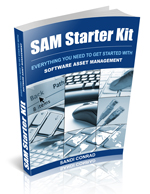Mergers and Acquisitions
 This article has been contributed by Sandi Conrad of Conrad & Associates.
This article has been contributed by Sandi Conrad of Conrad & Associates.
Sandi is the author of the “SAM Starter Kit” published by The ITAM Review.
One of several causes of compliance issues is poorly managed IT integration during mergers and acquisitions. A merger may be considered successful in all other aspects, transfer of employees, intellectual property, buildings, furniture and inventories, and yet the IT assets may be largely ignored. This may be due in part to the overall complexity of managing IT assets as well as the fact that the IT assets are not as easily recognizable as desks, vehicles and widgets.
Within each computer is the need to determine the value and components of hardware inventory such as hard drives, memory and network cards as well as the installed software. It doesn’t stop there however: software license, maintenance and support agreements as well as leasing facts on hardware are all details that cannot be ignored. Knowing what is installed, without proof of license is useless.
Often mergers and acquisitions take place without involving the IT team until the deal is signed and assets must be transferred. At that time it may become apparent that records were not properly maintained, that license certificates and proof of license may be missing or that lease return schedules are incomplete. This can be extremely costly and significantly impact the IT budget and the final costs of the merger/acquisition.
One way to avoid this is to create a policy that allows the M&A team to involve the Asset Manager earlier in the process or to have a standard set of criteria that must be achieved before determining the final value of the sale. Audits are requested regularly by watchdog groups and vendors, so asking for an audit should not raise suspicion within the employees of the company which is about to be acquired. Ideally, use of an inventory tool to create a list of hardware assets and software installations will be the fastest way to understand the first stage of asset acquisition. It will provide all of the hardware data as well as providing a list of software publishers for which license inventory will need to be sought. Many asset management companies will provide a 30-day license to complete an audit.
The second stage of the audit will require purchase history from vendors, including agreement or license certificate numbers and serial numbers for OEM or retail packaged software, as well as confirmation that proof of license has been stored appropriately and will be available if auditors wish to view them. This will be particularly important once the merger/acquisition has been completed as this information will be required for transfer of license, as well as providing a much stronger position for negotiating any future software agreements.
Regarding hardware, if products are leased and not owned, a schedule of lease return dates will also be required. This information is not typically required for an external audit, so may be a little more challenging to disguise from employees, but as a minimum, having a summary of the number of machines returning off lease each year will be helpful. Receiving commitment for a more detailed schedule will be required for merging the data once the merger/acquisition has been completed.
While it will be next to impossible to account for all software licenses during this process, a goal of having 80% of the software licenses accounted for will not be difficult, as this will be made up of a small number of vendors. Typically the other 20% of software installed will be a large number of specialized or single applications, shareware or freeware and may be removed or replaced once the merger/acquisition has been completed.
 This article has been contributed by Sandi Conrad of Conrad & Associates. Sandi is the author of the “SAM Starter Kit” published by The ITAM Review.
This article has been contributed by Sandi Conrad of Conrad & Associates. Sandi is the author of the “SAM Starter Kit” published by The ITAM Review.
Sandi has been in the software business since 1991 and was one of the first Software Contract Administrators in Canada.
She has been providing consulting services since 1996, helping hundreds of clients to understand their obligations and rights under a myriad of contracts, and comparing licensing programs to find the most advantageous options for her clients.
~
Can’t find what you’re looking for?
More from ITAM News & Analysis
-
ITAMantics - April 2024
Welcome to the April 2024 edition of ITAMantics, our monthly news podcast where we discuss the biggest ITAM stories from the last month. George is joined this month by AJ Witt and Ryan Stefani. Stories tackled ... -
Broadcom is removing expired VMware licences from its portal - take action now!
Hot on the heels of Broadcom’s announcement of the end of perpetual licences for VMware it has given customers barely a week to download any keys for licenses from its portal with expired support. This is ... -
Who Loses When Broadcom Wins?
News of a new Broadcom deal rarely arrives with great fanfare. The November 2023 VMware acquisition provoked open worry online and in business circles, with many critics wondering whether the former Hewlett-Packard spinoff’s reputation would prove ...